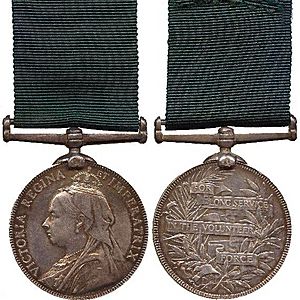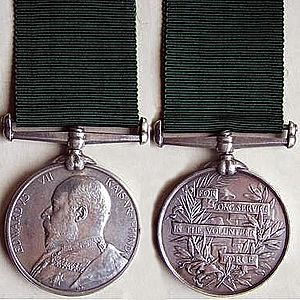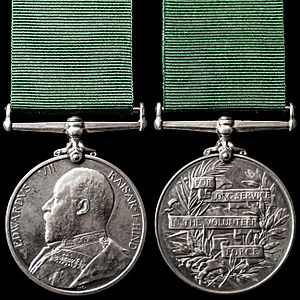Volunteer Long Service Medal for India and the Colonies facts for kids
Quick facts for kids Volunteer Long Service Medal for India and the Colonies |
|
|---|---|

Queen Victoria version
|
|
| Country | |
| Type | Military long service medal |
| Eligibility | Other ranks and Officers who have served in the ranks of the Volunteer Forces throughout the British Empire |
| Awarded for | Twenty years service Eighteen years service in India |
| Status | Discontinued in 1930 |
| Statistics | |
| Established | 1896 |
| Order of Wear | |
| Next (higher) | Volunteer Officers' Decoration for India and the Colonies |
| Next (lower) | Colonial Auxiliary Forces Officers' Decoration |
| Related | Volunteer Long Service Medal |
Ribbon bar |
|
The Volunteer Long Service Medal was a special award given to soldiers in the United Kingdom's part-time army, called the Volunteer Force. In 1896, Queen Victoria decided to create a similar medal for soldiers in the Volunteer Forces across the entire British Empire. This new medal was called the Volunteer Long Service Medal for India and the Colonies.
This medal was given out until 1930. It was slowly replaced by other medals, like the Colonial Auxiliary Forces Long Service Medal and later the Efficiency Medal.
Contents
How the Medal Started
The original Volunteer Long Service Medal was created in 1894. It was for soldiers who had served for a long time in the United Kingdom's Volunteer Force. Officers who had started as regular soldiers could also get it. To earn this medal, a soldier usually needed to serve for twenty years.
In 1896, Queen Victoria decided to expand this award. She wanted to include members of the Volunteer Forces in places like India, Canada, and other British colonies and protectorates. So, the separate Volunteer Long Service Medal for India and the Colonies was created. This medal looked very similar to the original one. However, it had different words on the front, depending on which king or queen was ruling at the time.
Who Earned This Medal?
To earn the Volunteer Long Service Medal for India and the Colonies, soldiers usually needed to serve for twenty years. But in India, they only needed to serve for eighteen years. A soldier's commanding officer had to recommend them for the medal. The service had to be continuous, meaning without big breaks.
If an officer received this medal and later earned a higher award, like the Volunteer Officers' Decoration for India and the Colonies, they had to give back the Long Service Medal.
What the Medal Looked Like
The medal was made of silver and was about 1.45 inches (3.7 cm) wide. It was a round disk with a raised edge. It hung from a straight silver bar that could swivel.
The Front of the Medal
The front of the medal showed a picture of the king or queen who was ruling. There were three main versions of the medal's front:
- The first version, from 1896, showed Queen Victoria. She was wearing her crown, a veil, and the Star of the Order of the Garter. Around her picture, it said "VICTORIA REGINA ET IMPERATRIX," which means "Victoria, Queen and Empress." Some of these Queen Victoria medals were given out even after she passed away in 1901.
- The next version featured Edward VII, who became king in 1901. He was shown in his Field Marshal's uniform. Around his picture, it said "EDWARDVS VII KAISAR-I-HIND," which means "Edward VII, Emperor of India" in the Hindustani language. Some of these King Edward VII medals were awarded even after he passed away in 1910.
- The last version showed George V, who became king in 1910. He was also in his Field Marshal's uniform. Around his picture, it said "GEORGIVS V BRITT: OMN: REX ET IND: IMP:," meaning "George V, King of Great Britain, Emperor of India."
The Back of the Medal
The back of the medal had a design of palm and laurel leaves. These leaves surrounded a scroll, which is like a rolled-up piece of paper. On the scroll, it said "FOR LONG SERVICE IN THE VOLUNTEER FORCE" in four lines.
The Ribbon
The ribbon for this medal was plain dark green. It was about 1.25 inches (3.2 cm) wide. This was the same ribbon used for the original Volunteer Long Service Medal.
When the Medal Stopped Being Given
Between 1899 and 1902, the Volunteer Long Service Medal for India and the Colonies started to be replaced. It was superseded by the Colonial Auxiliary Forces Long Service Medal in most British colonies and protectorates.
However, it continued to be awarded in a few places. It was given to soldiers in the Isle of Man Volunteers until 1920. It was also awarded in Bermuda and India until 1930. In 1930, the medal was finally replaced everywhere by the Efficiency Medal.
Images for kids




